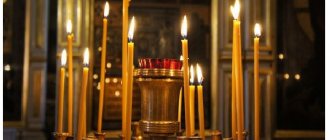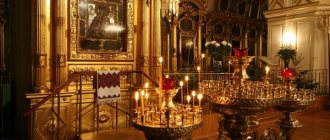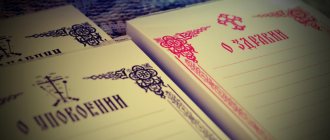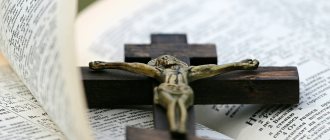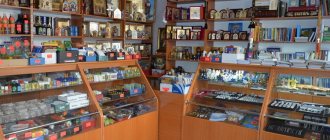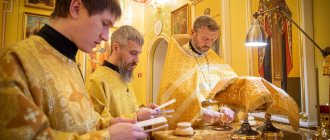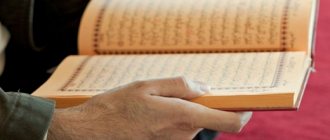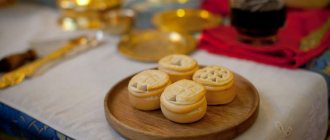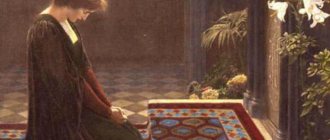Proskomedia is the preliminary part of the service of the Divine Liturgy.
At the moment of Proskomedia, wine and bread are prepared in order to perform the Sacrament of Communion in the future.
For proskomedia, five loaves of bread are used - prosphora, from which parts are taken out with a spear - a double-edged knife with a triangular blade.
The first prosphora - Lamb - serves to prepare the Lamb.
The second - Mother of God - for preparing a particle in memory of the Mother of God.
The third - nine-rank - for the preparation of nine particles - sacred symbols of the nine angelic ranks, as well as for commemoration; heralds of God's will - prophets; disciples of Jesus Christ - the apostles; saints - saints from the episcopal rank; martyrs; venerables - those who accomplished monastic feats; unmercenary; Equal to the Apostles - famous for the spread of Christian teaching - and compilers of the Liturgy.
The fourth prosphora serves to prepare two particles in memory of the living patriarchs, other clergy and the state, the people inhabiting it, the authorities and the state army. Particles are taken out of it to commemorate living people (about health).
The fifth prosphora is used to remove particles in memory of the deceased (the repose of souls).
All the removed particles are placed on a plate for the Lamb, or paten, and symbolize the one Christian church, where everyone is together and everyone is alive.
Proskomedia about health is a mention during the Liturgy - the Sacrament - of the name of a Christian along with the removal of a particle of prosphora. Particles for commemorating the living (about their health) are removed from the fourth prosphora.
Such a mention has extreme power, especially if it is ordered as a sorokoust - a commemoration during the forty daily Liturgies.
Proskomedia about health helps a person overcome spiritual temptations, anxiety, resolve difficult issues, cope with illness and, most importantly, cleanse himself of sins, since at the end of the ritual, all pieces of prosphora taken out for the living and deceased are lowered into a vessel with the Blood of Christ with a prayer for washing their sins.
Proskomedia for the repose is the commemoration during the Liturgy of the name of a deceased Christian along with the removal of a particle from the fifth prosphora. The particle is immersed in a chalice - a vessel with the Blood of Christ, bringing a bloodless cleansing sacrifice to the Lord.
By this action the soul is sanctified and receives grace from it. The sorokoust - the remembrance of forty proskomedias - has special power.
A memorial service is a special service to commemorate the dead. It is performed on certain days - on the first day after death, third, ninth, fortieth, name day, birth, death day (anniversary).
Proskomedia - commemoration during the Liturgy, the sacred Sacrament. This commemoration is performed at all times and helps the soul to wash away the sins accumulated in worldly (earthly) life and to find peace. The best option for commemoration is commemoration at all moments of the services that are provided for this.
Proskomedia differs from mass (Liturgy) in the time of remembrance and ritual. During proskomedia they commemorate by taking out particles of prosphora, and during mass they commemorate with litany and singing “It is worthy to eat,” according to notes. They do it out loud - publicly - or secretly.
In tradition, commemoration is considered ideal at all moments of the service that are intended for this. The special power of any of the commemorations does not differ from each other: as the magazine “Foma” says, stories about the effectiveness of a particular commemoration are a legacy of paganism, magic, and prejudice.
"Save me, God!". Thank you for visiting our website, before you start studying the information, please subscribe to our Orthodox community on Instagram, Lord, Save and Preserve † - https://www.instagram.com/spasi.gospodi/. The community has more than 18,000 subscribers.
There are many of us like-minded people and we are growing quickly, we post prayers, sayings of saints, prayer requests, we post useful information about holidays and Orthodox events in a timely manner... Subscribe, we are waiting for you. Guardian Angel to you!
It is almost impossible to know all the nuances and features of sacred rites in the Orthodox faith. It is very difficult to understand all the intricacies, which will take a lot of time, effort and patience. What is proskomedia in Orthodoxy - let's figure it out together in this article.
Proskomedia about health what is it
In the Orthodox faith, the most important thing during a church service is the liturgy or mass, during which the sacrament of communion is performed. To perform this ritual, you need red wine, prosphora or a slice of bread.
- The necessary components of the ritual are prepared in advance, in a special way. The priest, together with the deacon, put on sacred, elegant clothes and perform a ceremony on the altar, during which they read special prayers. It is worth noting that proskomedia are both about health and repose.
- Prosphora and red wine are required for the ceremony. It was these foods that Jesus consumed during the establishment of the sacrament. Since ancient times, to prepare sacred bread, parishioners brought various types of bread to church, from which the best were selected and used during church activities.
- The church ministers consumed the remaining baked goods during a friendly meal, which necessarily took place at the end of the liturgy.
- All parishioners of the temple were invited to the meal. People also brought oil, wine, sugar, incense and many other foodstuffs simply necessary for preparing a meal to the temple. All these gifts were called prosphora at proskomedia.
In the modern world, things are a little different. When going to church, parishioners do not take various dishes with them, and prosphora is usually called bread, which is baked by burnt priests themselves.
History of the formation of worship
The word “proskomedia” can be translated from Greek as offering.
In the first centuries, Christians brought bread for worship. The priest prayed over it, removed a piece for health or for the repose of souls, and the rest of the bread was returned to the one who brought it, or was distributed to the sick, the poor, orphans or widows. This is where the name comes from - offering.
But this is not the main task of proskomedia. This is a divine service performed before the divine liturgy (mass), at which wine and bread are prepared for the Eucharist. On it, bread, while remaining bread materially, is offered into the real body of Jesus Christ, and wine into His real blood.
Interesting! These are them - the 12 apostles of Jesus Christ: list of names
- Altar. Belonging to the altar. A small table designed for performing proskomedia. It symbolizes the den where Jesus Christ was born, as well as Golgotha, where He was crucified.
- Chalice (Chalice) - like a cup of wine during the Last Supper.
- Paten is a nativity scene.
- Star - symbolizes the Star of Bethlehem.
- The spear is the spear that pierced the side of the Lord Jesus.
- Pokrovtsy - shrouds with which the Infant God was wrapped.
- Prosphora at the proskomedia (5 pieces).
Notes on the Proskomedia
In church terminology there is the concept of a note for a proskomedia. Before the start of the liturgy, parishioners have the opportunity to write the names of their loved ones on a piece of paper. And during the service the priest will pray for them. More than once, everyone has seen pieces removed from a slice of bread.
In the entire prosphora, their number is equal to the number of names indicated in the note. During the liturgy, the crumbs are placed near a large prosphora, and at the end of the liturgy they are lowered into a bowl filled with wine. At this moment, the priest leading the liturgy reads a special prayer. It is worth noting that the note can indicate the names of only those people who have been baptized in the Orthodox Church.
In the Orthodox faith there are two types of notes:
Useful articles:
- about health;
- about repose.
Proskomedia about health
ordered immediately before the start of the service in the church. It is enough to write on a piece of paper, which you can take from the church near the counter with candles, the names of those people for whose health you want them to pray.
Similarly, a proskomedia for the repose
. It is very important to read the inscription on the piece of paper correctly so as not to get confused. In the church you can also order a commemoration at the proskomedia. To do this, it is enough to bring a note in the evening and be sure to indicate the desired date of the liturgy.
Answers to frequently asked questions
- Can you submit notes for anyone?
No, the Church prays for everyone: both the baptized and the unbaptized, but at the Eucharist, when pieces of the prosphora are taken out, only members of the Church are remembered, that is, the baptized. - If you submitted a note about commemoration, but did not know that the person was not baptized.
What will happen? If they did this not intentionally, but thinking that the person was baptized, then nothing will happen: neither to the person whose name was written down, nor to the one who submitted the note. - What will happen if you remember an unbaptized person, knowing this?
Nothing will happen to the one you remember. The one who did this intentionally needs to repent to the priest so as not to burden the soul with sin (otherwise, he may have to endure some kind of temptation, that is, trouble. For example, someone will deceive). - What happens if I accidentally wrote down the name of a living person in remembrance as a deceased person?
If this happened by accident, without malicious intent, do not worry. The Lord knows the intentions and deeds that they wanted to do the opposite. Therefore, it will be so: He will correct the mistake - He will remember for the health of the one who is alive. - If, when doing magic, they deliberately remember the living for their repose?
Nothing will happen to anyone against whom evil is plotted if he trusts in the Lord. Christ is stronger than demonic tricks. If a person wears a cross and prays, albeit briefly, for example, with the Jesus Prayer, then evil will return to the one who conjured it. Believe God, and nothing bad can be done to you.
Conclusion:
Imagine a person’s soul as a vessel filled with bitter water, 40 liters. They prayed for him and replaced a liter of bitter water with the same amount of sweet water. After praying forty times, all the liquid in the vessel will be replaced by sweet liquid. But we have much more sins, and we commit them constantly, so we do not receive complete replacement of the sinful component with the given Grace. The more measures are taken to cleanse the soul, and there are many of them, the faster the effect occurs. Wanting to help someone:
- get out of trouble;
- receive healing;
- tame an evil temper;
- improve family relationships;
- To protect you from all evil, you must pray constantly.
“Sorokoust” is an intensified commemoration, that is, the Heavenly Powers are invoked 40 times (either by day or by church). But it should be remembered that the Sacrament is not magic. If a person himself hates the church, or his loved ones do not want to pray for him, but rely only on the priest, then there may not be quick results.
What is the difference between proskomedia and mass?
The main difference between proskomedia and mass is the ritual and time of remembrance. During the service, the priest reads a prayer and takes out several pieces from the prosphora. And during the ceremony of mass, the church minister reads the notes, and the church choir at this time sings “It is Worthy to Eat.” Both rites are carried out publicly or secretly.
We have discussed what proskomedia is in Orthodoxy. But before it takes place, the deacon and priest prepare very carefully, which makes it possible to carry out the ceremony in accordance with all Orthodox rules. There are several most important and simply necessary nuances that must be observed:
- Before going to the altar, a prayer must be read. It is repeated immediately before the altar;
- To perform a sacred ceremony, the clergyman must wear clothes specially designed specifically for this rite;
- The church minister performs the hand washing procedure, during which he reads verses from the 25th Psalm.
The service itself takes a short amount of time. The deacon and the priest stand directly opposite the altar, on which are placed sacred vessels filled with an asterisk, a shroud, a chalice, a spear and a paten. Rituals using sacred bread are carried out while reading prayer verses.
After reading the prayer, the church ministers prepare for the liturgy, which is the solemn part of the service. It must also follow certain rules:
- glorification of the holy meal by all parishioners and the deacon;
- reading several prayers specifically intended for this rite;
- the deacon's request from the clergyman to proceed to the next part of the liturgy.
It is difficult to unequivocally answer the question of which is better: a proskomedia for health or a prayer service. Each church ceremony is individual and useful in its own way. In order to decide what kind of prayer you need in the current situation, it is recommended to seek help from the clergy.
The Lord is always with you!
). Believers gather in the temple for joint prayer. God Himself mysteriously dwells in the temple. The temple is the house of God. In the temple, the priests offer the Most Holy Bloodless Sacrifice. Even in Old Testament times, prayers were accompanied by the sacrifice of animals to cleanse sins and appease God. In the Church of the New Testament, animal sacrifice does not exist, for “ Christ died for our sins.”
" ().
“ He is the propitiation for our sins, and not only for ours, but also for the sins of the whole world
” (). He sacrificed His Most Pure Blood and Flesh for everyone and established at the Last Supper the Sacrament of Holy Communion, the offering under the guise of bloodless gifts - bread and wine - of His Most Pure Flesh and Blood for the remission of sins, which is performed in churches at the Divine Liturgy.
Church prayer has special power also because it is offered by a priest specially appointed to perform sacred rites and offer prayers and sacrifices to God for people. " I have chosen you and appointed you
“,” says the Savior to His Apostles, “
so that... whatever you ask from the Father in My name, He will give you
” ().
They transferred the rights given from the Lord to the apostles and the duties and powers assigned to them to the successors they appointed: bishops and presbyters, bequeathing to them the power, the right, and the indispensable duty, first of all... “to make prayers, petitions, supplications, thanksgivings for all people”
( ).
That is why the holy Apostle James says to Christians: “ Is any of you sick, let him call the elders of the Church, and let them pray over him
” ().
Funeral service
The funeral service is a funeral service that escorts the soul of the deceased to another world. The funeral service is performed in order to ask the Almighty in prayer to forgive the sins of the deceased and to allow him to find peace in the afterlife.
The funeral service for the dead is held in the church on the third day after death (if the death occurred on Tuesday, then the funeral service will take place on Thursday). If the day of the funeral service falls on Easter week, then instead of mournful funeral prayers, joyful chants of Easter are sung. The funeral service is postponed to the next day if it falls on the Feast of the Nativity of Christ and the Day of the Holy Resurrection of Christ.
It is recommended to perform a funeral service in a church, but if this is not possible, the church does not prohibit doing it at home. The coffin remains open throughout the entire funeral service. A crown of paper is placed on the forehead of the deceased as a sign that the person is leaving for another world as a victorious warrior. The white shroud with which the deceased is covered means the patronage of the church, which will forever pray for the soul of the deceased.
How often should memorial notes be submitted?
The prayer of the Church and the Most Holy Sacrifice attract the mercy of the Lord to us, purifying and saving us. We always, both during life and after death, need God's mercy towards us. Therefore, it is necessary to be worthy of the prayers of the Church and the offering of the sacrifice of the Holy Gifts for us or our loved ones, living and deceased, as often as possible, and necessarily on those days that have special meaning: on birthdays, baptism days, name days of both one’s own and members of your family. Honoring the memory of the saint whose name we bear, we thereby call on our patron to pray and intercede before God, because, as the Holy Scripture says, the intense prayer of a righteous person can do a lot
().
It is imperative to submit a note of remembrance on your child’s birthdays and baptisms. Mothers must carefully monitor this, because caring for the child is their sacred duty
. Whether sin attracts us to itself, whether some passion takes possession of us, whether the devil tempts us, whether despair or inconsolable sorrow befalls us, whether trouble, need, illness have visited us - in such cases, the prayer of the Church with the offering of the Bloodless Sacrifice serves as the surest means of deliverance, strengthening and consolation.
Should I order magpie in three or seven churches?
There is an opinion that the greater the number of churches it is ordered for, the greater the help from reading a prayer service (from three to seven).
The most powerful prayers:
| Number of temples | Peculiarities |
| 3 | Since ancient times, it was believed that ordering a magpie in three temples was the most effective means in the fight against corruption. This was connected with the magic of the number 3, the Holy Trinity, which is revered by all Christians. Important:
|
| 7 | This rite is considered one of the most powerful in Orthodoxy; it is compared to Unction. Ordering a prayer service in so many parishes is used when the help of the Lord God is especially needed. It has long been believed that monks are closest to God, so their prayer is extremely powerful. Seven magpies can help:
|
A reminder for those wishing to submit a note about the living and the deceased
1. Notes must be submitted before the start of the liturgy. It is best to submit notes of remembrance in the evening or early in the morning, before the start of the service.
2. When writing down the names of the living and the dead, remember them in the process of writing with a sincere desire for their good, from the bottom of your heart, trying to remember the one whose name you are writing in -
this is already a prayer
.
3. The note must contain no more than ten names. If you want to remember many of your family and friends, send a few notes. 4. Names must be written in the genitive case (answer the question “who?”). The names of bishops and priests (priests) are indicated first, and their rank is indicated - for example, “about the health” of Bishop Tikhon, Abbot Tikhon, Priest Yaroslav, then write your name, your family and friends. The same applies to notes “about the repose” - for example, Metropolitan John, Archpriest Michael, Alexandra, John, Anthony, Elijah, etc. 5. All names must be given in church writing (for example, Julia, not Yulia) and in full (for example, Alexander, Nikolai, but not Sasha, Kolya), 6. The notes do not indicate last names, patronymics, ranks and titles, degrees of relationship. 7. A child under 7 years of age can be indicated in a note as an infant - baby John.
8. If you want, in health notes you can mention “sick”, “warrior”, “travelling”, “prisoner” before the name. They don’t write in notes – “suffering”, “embarrassed”, “needy”, “lost”. 9. In the notes “On repose” the deceased is referred to as “newly deceased” within 40 days after death. It is allowed in notes “On repose” to write before the name “killed”, “warrior”, “of ever-memorable” (day of death, name day of the deceased).
Is it possible to write in notes “For health” and “For repose” of people for whom it is unknown whether they have been baptized?
The notes that are given to the altar at the proskomedia list the people for whom the Holy Church makes the Bloodless Sacrifice at the liturgy. Therefore, it is understood that all these people are not only baptized, but also recognize themselves as members of the Church. If people are baptized, but do not live the church life (), then it is more appropriate to submit notes for them for commemoration when reading the Psalter.
How to write in notes the names of people whose names are not in the calendar?
The tradition is to baptize with a name “from the church calendar”, i.e. according to the calendar, this is only a good Russian tradition, which does not exclude the commemoration of those Christians whose names do not correspond to it. There is even a special circular on this topic:
“The Moscow Patriarchate receives letters that draw attention to cases of denial of liturgical commemoration and participation in the Sacraments in relation to those Orthodox believers who are baptized in other Local Orthodox Churches (for example, in the Bulgarian, Georgian, Romanian, Serbian, Finnish, etc. etc.) with the naming of names that are not in the monthly calendar of the Russian Orthodox Church. In the traditions of some Local Churches, at baptism it is allowed to name babies with national names that are not in the church calendars. In connection with the above, with the blessing of His Holiness, His Holiness Patriarch Kirill of Moscow and All Rus', I remind you that no restrictions should be allowed in liturgical commemoration and admission to the Sacraments of the Church for believers bearing national names and baptized in other Local Orthodox Churches. I ask you to convey this information to the abbots of the monasteries and parishes of the diocese entrusted to you.”
People who have recently started going to church find it difficult to understand the meaning of church services. One of the sacred rites that raises many questions is proskomedia
. How it goes, how this ritual differs from simple prayer for loved ones, we will consider below.
Sorokoust
Sometimes in church you can see people ordering the so-called “sorokoust”. Sorokoust is a special, enhanced prayer of the Church for the health or repose of its children. During the forty Divine Liturgies, the serving priest at Proskomedia commemorates the person (more precisely, his name) served on the magpie.
There is a practice when notes are commemorated at the evening service, and then again in the morning at the liturgy. The particles taken out in the evening are stored in a special closed container. At Proskomedia, the priest transfers all these particles to the paten, where the Lamb is located - the sacred bread, which is to become the Body of Christ.
| Patriarch, Metropolitan, archpriest, priest, deacon, monk - respectively. This is the meaning of clergy titles. | |
| IN. | Warrior |
| Cont. | Not idle. That means she's pregnant. |
| Jr. | Baby. For children under 7 years of age. |
| Neg. | Youth. Children aged 7 - 14 years. |
| B. Bol. | Sick |
| Ub. | Murdered |
| New | Newly deceased. Deceased no earlier than 40 days ago. |
Proskomedia - what is it?
Proskomedia
called the first part
of the Divine Liturgy
(or
mass
). Mass is a common word. This is how in Rus' they called the morning church service, which ended before lunch.
At the proskomedia, clergy prepare bread and wine for the sacrament of the Eucharist ()
. The bread symbolizes the Flesh, and the wine symbolizes the Blood of the Savior, shed for us. The sacrament is performed in memory of the Last Supper, at which Jesus Christ first performed the rite of communion for his disciples. It reminds us that the Savior, for the sake of our salvation, left us not only teachings and covenants, but also gave all of himself. By receiving communion, we unite with God and receive his grace.
The Eucharist also symbolizes the unity of all Christians
. It was not for nothing that Jesus Christ, while treating his disciples, broke off pieces of one piece of bread. When the Church arose, parishioners themselves brought different types of bread, red wine, as well as butter, sugar and other products to the service. The best of them were used during the liturgy, the rest was eaten at a common dinner after its end. This emphasized the commonality of all those present in the temple.
That is why, translated from Greek, “proskomedia” means “to bring.” The bread used during the ceremony is called “prosphora” - from the Greek “gift”.
Today, the tradition of bringing products necessary for the liturgy to church has been lost. Bread is usually baked by the wives of priests or widows from among the parishioners. The requirements for it are as follows:
Just as wheat gives life only after its death, ground and turned into bread, so the Savior gave humanity a chance at eternal life by dying on the cross.
The wine for proskomedia is red, made from grapes. This is the kind of wine that Jesus Christ drank, as mentioned in the Bible. Since the 19th century, Cahors has been used in churches for this purpose. In those days, this brand of wine was the best. It is customary to dilute it with water. This is a reminder of the moment when a warrior pierced the rib of the Savior hanging on the cross with a spear. Blood and water flowed from the wound.
During proskomedia, both living Christians and deceased Christians are commemorated. The tradition of remembering loved ones and praying for them is very ancient. In order for the priest to read the names of people close to you at the altar, you can write notes in advance. They are usually served in the evening or early morning before the start of the liturgy. In notes it is permissible to indicate only those people who were baptized during their lifetime. It is also prohibited to submit notes with the names of suicides.
In some temples there is a division of notes into ordinary
and
custom ones
.
When we submit a regular note
, at the proskomedia, particles are taken out of the prosphora according to the number of names indicated, which are then dipped into the wine. This symbolizes the cleansing of the commemorated souls through the blood of the Savior.
Names from registered notes
They additionally sound during litanies; the priest pronounces them in front of the altar. After the liturgy, prayer for the health of the living continues during the prayer service, and remembrance of the dead continues during the memorial service.
Church prayer is very powerful. Therefore, it is customary to order commemoration during the proskomedia of those people who are sick or in need of God’s support and guidance on the true path. “Health” in Orthodoxy means not only physical and mental health, but also a person’s well-being, material wealth, and spiritual aspirations.
In health notes, it is recommended to write first the names of the Patriarch, Archpastor, and Most Reverend Bishop, on whom the well-being of the entire flock depends. Then the name of the spiritual father who instructs the person is indicated. Next come the names of relatives and close people. At the end of the note you can write the names of enemies, envious people, ill-wishers. Praying for their health, we ask God to bring harmony into the souls of our enemies, to reconcile them with those around them.
Repose notes
Commemoration of the deceased who left a mark on our soul allows us to feel unity with them. Orthodoxy teaches that there is no death. The souls of people are eternal, and with our prayer we can help the departed in their heavenly life. Just like they help us from there.
Repose notes should be submitted regularly, especially on the birthday and death of the deceased, on the day of baptism, and on name days.
There are several rules that will help you write a church note correctly. Let's list them:
Notes for the proskomedia are submitted separately from notes for the prayer service and memorial service.
Monastery or temple – which is better to order?
More precisely, this question can be formulated as follows: where to order, to the church where liturgies are served every day, or to the one where they are served only on certain days? Naturally, according to the meaning of the magpie and in accordance with all of the above, it is better to order to a place where the liturgy is served daily.
In this sense, a monastery is, of course, preferable, since services there, as a rule, are performed every day. In addition, the monks are more pious and diligent in their approach to the service, in particular to the commemoration of the Magpies.
But otherwise, the grace given at their commemoration is the same in the monastery and in the parish church. However, a separate issue is the commemoration of the Magpies in those churches where liturgies are not served every day. There they are remembered in different ways. In some, they are simply read out every day on time, whether there is a liturgy or not. In others, they are commemorated only at liturgies—forty or more liturgies.
Is it possible to order a magpie about health for yourself?
Of course you can; especially with various everyday adversities. Only in this case is it advisable to remember those who also suffer in these adversities, for example, members of your family.
You can sign up for eternal remembrance not only for yourself, but also for your loved ones. This is a special type of commemoration of an Orthodox Christian during the time that the temple or monastery where the request for commemoration was submitted stands. Experienced spiritual people say that if there is no one to pray on earth, then angels in heaven will pray.
Why do they order the magpie about health in three churches on one day?
For deep prayer. Although this practice is not very common for various reasons. Yes, in essence, prayer in one church is sufficient, if only we ourselves pray to God, asking Him for what we want to receive.
How many times can you order a magpie for the repose of one person?
As many times as you like, even for the rest of your life! This depends on our love for the deceased, our zeal in commemorating him, and also on our availability of appropriate material resources. After all, in this case, it makes more sense to apply over and over again for the whole year. And this is a financially quite expensive commemoration.
Where can I order a magpie for suicides?
The Orthodox Church does not pray for suicides, so our churches do not accept such magpies. By the way, when accepting them, as a rule, they immediately clarify whether among the recorded names there are suicides, unbaptized people, etc.
True, there will probably be crafty gatherings of some sectarians or swindlers who will accept such a magpie for a lot of money. But if these deceivers pray for a suicide, this will make his fate in the afterlife, at best, not change, and in another, it will only become much worse.
What should the relatives of such unfortunate people who committed suicide do? Orthodox Christians can pray for them with their personal prayer, both at home and during worship in church. There are special moments during the liturgy when it is especially convenient for parishioners praying during it to remember any of their relatives (even suicides) for their repose. This is a proskomedia, when the priest himself takes out the pieces for the repose; as well as the words of the priest “Peace to all” after the Great Entrance.
Does magpie help against damage?
Of course it helps. But at the same time, we must remember that damage is caused by witchcraft. When sorcerers call on demons to help them, who do various dirty tricks on us, in particular, they cause damage. However, they can do this only because of our sins, and the more sins we have, the more harm the demons will cause us.
If a person has been damaged for his sins, then the first thing he needs to do is reduce them. Of course, magpie helps with this. But the main thing here is a person’s repentance of his sins in confession before a priest, as well as communion of the Holy Mysteries. To the one who received communion, i.e. Having united with Christ, demons, as a rule, are afraid to approach.
Well, and most importantly, you need to sin less. If someone who has been damaged for his sins will give his health to the church; even if he confesses and takes communion, but does not stop sinning, all these sacred rites will help him little. And he himself will look like a man who scoops water into a bucket without a bottom. No matter how much you draw, you still won’t get enough to drink from this bucket!
Procedure for holding the proskomedia
The proskomedia takes place in the altar, hidden from the parishioners, behind the closed Royal Doors. Jesus Christ came into our world in the same way. At this time, the Hours according to the Book of Hours are read. Before the ceremony, entrance prayers are read, the priest dresses in special clothes and washes his hands.
Preparation of the Lamb
Five prosphoras are baked, which should remind Orthodox Christians of the five loaves with which Jesus Christ fed five thousand people. This is a symbol of spiritual saturation, which can only be obtained through the Savior. Directly for the sacrament of the Eucharist, only one of the prosphoras is used - the Lamb. Just as Jesus broke one bread for all his disciples, so there should be enough Lamb for all who partake.
The priest approaches the altar and cuts out a quadrangular part from the lamb prosphora, which is called the Lamb. In Old Testament times, a lamb was sacrificed to God to atone for a sin committed. A pure, innocent, meek creature suffered for the sins of others. John the Baptist called Jesus Christ the Lamb of God, because He came into our world not to live, but to die for us.
This part of the ritual symbolizes both the birth and death of the Savior. The cut out part of the prosphora is placed on the paten, which is both a manger and the Holy Sepulcher. The priest pierces the right side of the lamb with a spear, just as the warrior pierced the side of Jesus Christ with a spear. After this, wine diluted with water is poured into the chalice (a special bowl), as a symbol of the blood shed on the cross.
Removing particles from other prosphoras
The rest of the prosphora at the proskomedia also have their own meaning
.
- The second prosphora is called the Mother of God. A triangular piece is taken out of it as a sign of remembrance of the Mother of God and placed on the paten to the right of the Lamb.
- The third is “nine days”. Nine parts, symbolizing all the saints, are removed from it and placed to the left of the Lamb.
- Two parts are taken out of the fourth prosphora: one for all living clergy, the second for the health of all living Orthodox laity. They are placed below the Lamb.
- The last thing the priest places on the paten is the part taken from the fifth prosphora. It symbolizes the remembrance of all the departed.
Now comes the turn of small prosphoras served by parishioners. From them, the number of particles corresponding to the number of names in the attached note is taken out. The names are read out, a prayer is read for the health of the living and the repose of the dead. The particles are placed on the paten.
All particles taken from the prosphora symbolize the One Church, earthly and heavenly, in the center of which is Jesus Christ. Here are the saints, the lost, the living and the dead, those in health and the sick, even those who have forgotten about God, those who have abandoned Him - all those who are not indifferent to God, for whom we pray.
At the end of the Liturgy, the particles are dipped into wine. This is a sign that everyone close to the Savior will be washed from sin by his blood and forgiven.
At the end of the ritual, an asterisk is installed on the paten, reminding believers of the Star of Bethlehem. The paten and chalice with wine are covered with three cloths, which symbolize both the swaddling clothes of the baby Jesus and the burial shrouds. The end of proskomedia means the death of Jesus Christ, the end of his earthly life.
The priest censes the altar, thereby depicting the fragrance of incense brought by the Magi as a gift to the baby. He prays to God to accept gifts in the form of prosphoras soaked in wine, to remember those who brought them and those for whom they were presented.
Then he opens the Royal Doors, which symbolizes the Resurrection of the Lord, his entry into the Kingdom of Heaven and at the same time our salvation. This is how the solemn part of the liturgy begins.
In Orthodoxy, it is believed that commemorating loved ones at proskomedia has enormous power. Thanks to this ritual, terminally ill people are cured and the deceased find salvation. However, it differs from simple and for repose.
During the proskomedia, the whole Church gathers at the paten; through the blood of Jesus Christ, the boundaries between life and death, the Heavenly Kingdom and the earthly are erased. By taking out a piece of prosphora and calling a name, we sacrifice our loved ones to God, just as Jesus Christ sacrificed himself. Together with him, they symbolically die to a sinful life and are resurrected to eternal, healed, spiritual life. It is for such a life that man was originally created, even before the commission of original sin. Thanks to the Savior, we have a chance to enter it again.
Proskomedia is the most important commemoration of the living and the dead.
At the Liturgy, the priest takes out particles from the prosphoras about the health and repose of those for whom the believers submitted notes.
At the end of the Liturgy, the particles taken from the prosphora are immersed in the Holy Chalice, at which time the priest pronounces the words: “Wash, O Lord, the sins of those who were remembered here by Your honest Blood, by the prayers of Your saints.” The particles come into contact with the Body and Blood of Christ the Savior.
This is the power and effectiveness of removing parts from the prosphoras.
This is not just a prayer for this or that living or dead, but the cleansing of sins by this very bloodless Sacrifice. Here each part, imbued with the Blood of the Savior, becomes an intercessor before Him for the one about whose name it was taken.
That is why taking out from the prosphora a particle about someone living or dead during the Liturgy in the Orthodox Church has always been considered the most saving and fruitful action.
Proskomedia also symbolizes the birth of Jesus Christ and is performed in the altar secretly for the believers in the church, just as the birth of the Savior took place secretly, unknown to the world.
How to order a magpie commemoration for six months, a year, 5 years?
To do this, you need to come to the temple, go to the shop where they sell candles and say: “I need to order a magpie/ for six months/ for a year/ 5 years
About health/repose and name the person.
How to order a one-time memorial?
To do this, you need to write a note yourself (you can do it at home, you can take a form from the church shop), in which you can enter up to 10-15 names.
“On repose” and “On health” are submitted separately. This note must be given to the seller in the shop.
memorial notes are always paid
Therefore, YOU CAN ONLY SUBMIT NOTES TO THE ALTAR FOR THOSE BAPTIZED IN ORTHODOXY! 40-mouths are also not accepted for suicides.
IN OUR TEMPLE, in addition to a one-time commemoration at the proskomedia, you can also apply for a LONG-TERM REMEMBER. The difference in such remembrance is only in time - the period of remembrance (A PARTICLE IS TAKEN OUT FROM THE PROSPHORA). In some other temples the particle is not removed for a period longer than the fortieth day.
YOU CAN SERVE SOROKOSTA IN SEVERAL TEMPLES
SOROKUST
forty Liturgies in a row
6 months
remembrance of health/repose at all liturgies for six months
1 year
remembrance of health / repose
at all liturgies for one year
5 years
remembrance of health / repose
at all liturgies during
Commemorations of health are ordered not only for sick people, but also for healthy people - so that the Lord would protect them, help them in their good deeds, give them mental and physical health, and also help them in correction.
Why is such a time period chosen for some commemorations as forty days? We know from Holy Scripture and Tradition that often in order to achieve a certain spiritual result, a feat that lasts exactly 40 days is needed. There's a secret here.
We also know from patristic revelation that the soul of a deceased person on the fortieth day after death receives a determination of its fate at the private court of God. And therefore we especially pray during this period. From the above it follows that there is meaning in continuous forty days of prayer.
Elder Schema-Archimandrite Zosima noted that the entire history of mankind is measured in “weeks and forties.” “For forty days Christ appeared to his disciples, remaining on earth until the Feast of the Ascension of the Lord. The holy holiday is the fortieth day of the Ascension of the Lord. We celebrate Easter on the eve and will celebrate the great annual holiday on the fortieth day after Easter - the Ascension of the Lord. Sorokoust - forty days of fasting, forty days of Easter, everything comes in forties, weeks and forties. And the history of mankind also goes on in weeks and forties.”
What happens if you give forty-one for the death of a living person?
It depends under what circumstances and for what purpose. If this goal is malicious - to cause harm to the person being commemorated, then, on the contrary, the one who committed such a grave sin will harm himself.
Photo by Fedor Arkhutich
But there are other situations.
In the lives of the saints, a case is mentioned when the parents of one young man, captured by foreigners, considered him dead and performed funeral commemorations for him; Probably, magpies were also given for his repose. But such a prayer from his parents, performed by them out of ignorance, turned out to be very beneficial for him. For during it he felt relief in captivity, and ultimately was even freed from it and returned to his father’s house.
So the main thing here is the intention of those commemorating. If they wanted good for the person commemorated, mistakenly considering him dead, then God will reward him alive with this same good, but as if he were alive. It is we who may be mistaken, thinking about the living that they have died. But the Lord is omniscient - and knows who to give what!
What to do if you ordered a message about health and
the patient is on the mend
And great! This means that prayer helped him - let him be remembered in church for a long time. After all, by remembering health one prays not only for physical health, but also for the other well-being of the person for whom one is praying. So extra goodness won’t hurt him, because it’s never superfluous!
the patient got worse
Then you should intensify your prayers to help the sick person. However, everything is in God’s hands.
the person died
Everything is God's will. You should pray for the repose of the soul of the deceased. Go to the temple where the magpie is served. And ask to copy the name in the notebook “for the death” for the paid period. However, if you wish, you can, by paying extra, add it to forty days, during which the soul of the deceased will undergo ordeal.
